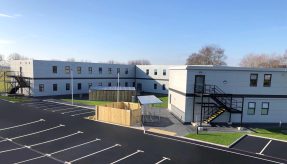
The shift towards electrifications represents a crucial advancement for the defence sector in the context of sustainability, says Jason Schneider, Head of US electrified powertrain at Drive System Design (DSD). The defence industry consumes a significant amount of fossil fuel and generates significant carbon dioxide emissions, which could be partly offset by improved electrified propulsion and power distribution solutions.
While electrification opens the door for many possibilities in the sector, however, the shift towards electric is not something that can or will happen overnight. Current approaches to the development and testing of propulsion and motor control systems are costly and time-consuming, and new and innovative methods are needed to make an electric future in defence an effective and viable reality.
Benefits of electrification in defence
This transition to electric would result in substantial cost savings, especially in fuel, as exemplified by the U.S. Army’s expenditure of $947 million on fuel in 2017. Given the current energy economy, this expense would be notably greater if incurred today.
In addition to sustainability advantages and cost-effectiveness, electrification could potentially contribute to saving lives on the battlefield. A study conducted by the U.S. Army in 2009 revealed that in Iraq, one casualty occurred for every 39 fuel convoys. While in Afghanistan, the figure was one for every 24 fuel convoys. By decreasing the requirement for fuel, fewer soldiers will be needed to support fuel transportation it to the frontline, thus minimising the risk to life.
Current manufacturing and testing processes for defence vehicles
The existing process for testing defence vehicle systems is highly classical and typically involves several stages: prototype development, in-vehicle testing, and then design iteration to address issues or opportunities for improvement. Given the diverse range of use cases and the end-users themselves, repeated rounds of physical testing is the accepted way to develop these new vehicle platforms.
This process is extensive and rigorous, often including multiple iterations and testing of different prototypes to address issues and often react to evolving requirements. The process of repeat physical testing, so commonplace in the defence space, is what gives rise to the extremely lengthy system development timescales and the significant investment needed to support this activity.
The reliability and durability of propulsion systems are so important because of the safety-critical nature of the vehicles in question. When electrification is added to the equation, there is even more emphasis on the need for highly reliable motor control and fault detection techniques. This sensitivity to fault tolerance could contribute to even more testing requirements and further prolong the time to deployment.
Therefore, there is a pressing need for advanced testing techniques and robust design analysis to come into play earlier in the development stage to reduce risk, ensure safety and reliability, and accelerate the development cycles of new defence vehicle platforms.
Innovation to embrace electrification
Innovating new propulsion systems is essential to embracing electrification and combatting many of the challenges currently faced in the defence sector. Fortunately, there are novel approaches to early motor control development that could help alleviate potential issues and better position defence OEMs to be first time capable – meaning successful in their first propulsion system attempt instead of having to continuously go back to the drawing board and iterate new solutions.
One such approach, developed by Drive System Design (DSD), involves a four-phase simulation-led process that begins with co-simulation of the motor and power electronics hardware, revealing the unique characteristics and performance of the combined system when these subsystems are coupled. Using extremely powerful Hardware-in-the-Loop equipment (HiL), the motor is then emulated while the inverter control board is linked to the HiL, creating a control HiL (C-HiL) that enables robust validation of the basic control architecture.
With test work going on in parallel to hardware procurement, real-world issues can now be predicted or reproduced and solved before, or concurrently with, dyno or test cell work, breaking the traditional cycle of going to the dyno before fully vetting the system only to face potentially costly setbacks to timing and budget. By testing in a controlled and known environment, engineers can subject the system to a wide range of faults and threats, allowing them to identify and debug issues much earlier in the development process. This early motor control development methodology is a promising way to predict, detect, and mitigate risks while increasing the efficiency and speed of defence vehicle development.
Transformation through simulation
The emergence of simulation-led development methods is revolutionising the e-mobility industry, and these techniques are now applicable to the defence sector too. These new methods provide a way for companies to manage risk, reduce cost, and speed up development time when adapting to new technologies. With simulation-led testing, engineers can create more robust, fault-tolerant systems.
This is especially important for the defence sector, where vehicles operate in harsh and challenging environments, and so must be robustly proven for overall safety and reliability. By testing in a controlled environment, companies can conduct ever more extensive testing, investigate issues more deeply, and refine their systems more quickly.
Overall, the incorporation of sustainable and secure technologies into the defence sector’s electric future promises to enhance the efficiency and efficacy of military operations while simultaneously diminishing the environmental impact and the danger to human life. While the current approach to testing systems in defence vehicles is rigorous and extensive, simulation-led testing methods provide an innovative solution that can mitigate risks, help to ensure safety and reliability, and accelerate the development cycles of defence vehicles. By embracing these new development and test methods, companies can create more robust, fault-tolerant systems and gain a competitive edge in the market.
If you would like to join our community and read more articles like this then please click here








